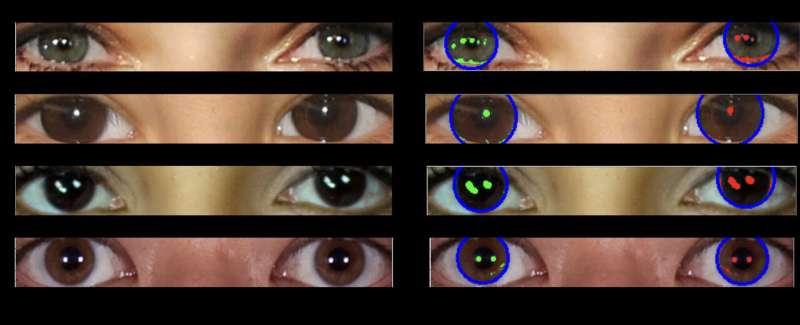
In an era when the creation of artificial intelligence (AI) images is at the fingertips of the masses, the ability to detect fake pictures—particularly deepfakes of people—is becoming increasingly important.
So what if you could tell just by looking into someone's eyes?
That's the compelling finding of new research shared at the Royal Astronomical Society's National Astronomy Meeting (NAM 2024) in Hull, held July 14–19, which suggests that AI-generated fakes can be spotted by analyzing human eyes in the same way that astronomers study pictures of galaxies.
The crux of the work, by University of Hull MSc student Adejumoke Owolabi, is all about the reflection in a person's eyeballs.
If the reflections match, the image is likely to be that of a real human. If they don't, they're probably deepfakes.
"The reflections in the eyeballs are consistent for the real person, but incorrect (from a physics point of view) for the fake person," said Kevin Pimbblet, professor of astrophysics and director of the Center of Excellence for Data Science, Artificial Intelligence and Modeling at the University of Hull.
Researchers analyzed reflections of light on the eyeballs of people in real and AI-generated images. They then employed methods typically used in astronomy to quantify the reflections and checked for consistency between left and right eyeball reflections.
Fake images often lack consistency in the reflections between each eye, whereas real images generally show the same reflections in both eyes.

"To measure the shapes of galaxies, we analyze whether they're centrally compact, whether they're symmetric, and how smooth they are. We analyze the light distribution," said Professor Pimbblet.
"We detect the reflections in an automated way and run their morphological features through the CAS [concentration, asymmetry, smoothness] and Gini indices to compare similarity between left and right eyeballs.
"The findings show that deepfakes have some differences between the pair."
The Gini coefficient is normally used to measure how the light in an image of a galaxy is distributed among its pixels. This measurement is made by ordering the pixels that make up the image of a galaxy in ascending order by flux and then comparing the result to what would be expected from a perfectly even flux distribution.
A Gini value of 0 is a galaxy in which the light is evenly distributed across all of the image's pixels, while a Gini value of 1 is a galaxy with all light concentrated in a single pixel.
The team also tested CAS parameters, a tool originally developed by astronomers to measure the light distribution of galaxies to determine their morphology, but found it was not a successful predictor of fake eyes.
"It's important to note that this is not a silver bullet for detecting fake images," Professor Pimbblet added.
"There are false positives and false negatives; it's not going to get everything. But this method provides us with a basis, a plan of attack, in the arms race to detect deepfakes."
Citation: Astronomy methods applied to reflections in eyes could help with spotting deepfakes (2024, July 17) retrieved 17 July 2024 from https://techxplore.com/news/2024-07-astronomy-methods-eyes-deepfakes.html
This document is subject to copyright. Apart from any fair dealing for the purpose of private study or research, no part may be reproduced without the written permission. The content is provided for information purposes only.
